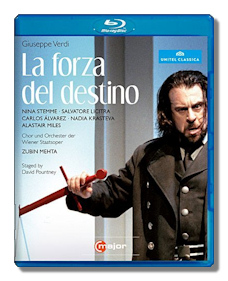
The Internet's Premier Classical Music Source
Related Links
- Verdi Reviews
- Latest Reviews
- More Reviews
-
By Composer
-
Collections
DVD & Blu-ray
Books
Concert Reviews
Articles/Interviews
Software
Audio
Search Amazon
Recommended Links
Site News
 Blu-ray Review
Blu-ray Review
Giuseppe Verdi

La Forza del Destino
- Donna Leonora - Nina Stemme
- Don Carlo di Vargas - Carlos Álvarez
- Don Alvaro - Salvatore Licitra
- Il Marchese di Calatrava/Padre Guardiano - Alastair Miles
- Preziosilla - Nadia Krasteva
- Fra Melitone - Tiziano Bracci
- Curra - Elisabeta Marin
- Un alcalde - Dan Paul Dumitrescu
- Mastro Trabuco - Michael Roider
- Un chirurgo - Clemens Unterreiner
Vienna State Ballet
Vienna State Opera Chorus & Orchestra/Zubin Mehta
David Pountney - stage director
Richard Hudson - set and costume designer
Fabrice Kebour - lighting designer
Beate Vollack - choreographer
Recorded live at the Vienna State Opera - March, 2008
Unitel Classica Blu-ray 708204 161min LPCM Stereo DTS-HD 5.0
Also available on DVD 708108: Amazon - UK - Germany - Canada - France - Japan - ArkivMusic - CD Universe - JPC
In my review of Berg's opera Lulu, also posted in this update, I led off talking about the lack of visual or special effects in opera. Well, lo and behold, this production does indeed employ special effects, rather rudimentary ones by Hollywood standards, but special effects nonetheless. In this rendition of Verdi's La Forza del Destino director David Pountney uses sort of ghostly video projections throughout much of the opera. For example, in Act III there are scenes of war projected in the background, and inasmuch as war is in the air here, this device is not out of place. Still, it goes on a bit and rather makes it point again and again. There are many other projected images or vague figures in this production, some of a quite graphic nature. In Act II, for instance, as Leonora pleads to be saved from her vengeful brother, a shadowy revolver spins slowly across the screen, then a bullet floats and tumbles and is followed by spattered, dripping blood. (In Act III the bullet is shown piercing the Marchese with blood gushing.) Despite their possibly unsettling character, these images are actually quite effective in giving the opera's theme of coincidence, or happenstance, a more grim sense.
To those unfamiliar with the story, let me just quickly summarize. In Act I Leonora, who is planning to elope with Alvaro against the wishes of her father, watches as he is killed by an errant bullet from a revolver that Alvaro had thrown to the floor. Her brother Carlo then swears vengeance on her and Alvaro and pursues them throughout the opera. In the end, wounded by Alvaro, the dying Carlo kills his sister. It's a bloody story with a libretto that is generally viewed as flawed.
The sets here may provoke a bit a controversy. Act I takes place entirely on a long but rather narrow white ramp. The ramp is retained for the later acts, but the stage area expands: the ramp takes on a huge cross-like shape near the end of Act II, and in Act III some tower-like structures with multiple stairways are used. While there is often a barren appearance on stage, the sets and video effects give the production a colorful and atmospheric character. Costuming is another slightly controversial aspect here. The Gypsy Preziosilla is dressed as a cowgirl and is surrounded by a chorus of cowboys and cowgirls. Others in the production wear modern dress, but Padre Guardiano is clad in a business suit, not in clerical garb. Perhaps he is secularized because, as "Father" Guardiano he is like a "father" to Leonora, and he is played here by Alastair Miles, who also portrays her father.
As for the quality of the singing, I can report that it is generally excellent. Nina Stemme makes a most effective Leonora, despite a slight lack of warmth in her voice. She has scored great success in Wagner and her voice may be better suited to roles like Isolde and Brunnhilde, which she has sung to great acclaim. Though she has a slight wobble in her middle and lower registers, she is still thrilling and thoroughly convincing as Leonora here. Salvatore Licitra, whose career was tragically cut short by a motor-scooter accident in 2011, is a fine Alvaro. Carlos Álvarez is splendid in the role of Carlo and Nadia Krasteva is in fine voice and makes an alluring Preziosilla.
The chorus sings splendidly and the orchestra performs admirably for veteran conductor Zubin Mehta. All in all, this is an imaginative and well-sung La Forza. In 2009 I reviewed another video performance of this opera here at Classical Net and found it mostly good. That effort, also led by Mehta and issued on TDK DVWW-OPFORZA, featured Violeta Urmana as Leonora, Marcello Giordani as Alvaro and Carlo Guelfi as Carlo. They were a fine cast, though I think the Unitel Classica stars have the edge in the vocal department. However, if you favor a more traditional approach in sets and costuming, you might prefer the slightly older TDK to the more daring and imaginative effort here. The sound and camera work on the Unitel Classica are excellent and add to the production's considerable strengths. Highly recommended.
Copyright © 2012, Robert Cummings





















